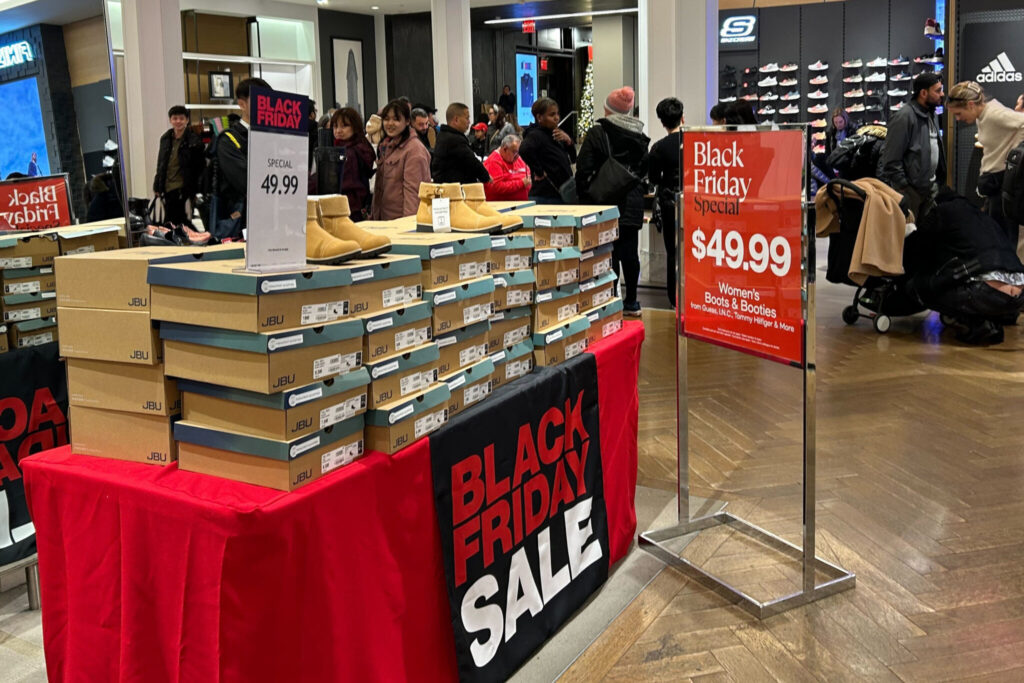Black Friday 2024/ holiday shopping trends/ Cyber Monday deals/ in-store discounts/ online sales growth/ retail foot traffic/ holiday sales predictions/ NEW YORK/ Newslooks/ J. Mansour/ Morning Edition/ Despite online shopping’s rise, Black Friday continues to be a pivotal day for retailers, driving foot traffic and major sales. Businesses are offering exclusive deals and immersive in-store experiences to attract shoppers. Analysts predict a steady holiday season with bargain-focused spending dominating the long weekend.

Black Friday Shopping Trends: Quick Look
- Key Event: Black Friday remains a critical retail event despite early online sales.
- In-Store Focus: Retailers emphasize physical shopping experiences to boost impulse purchases.
- Economic Outlook: Holiday spending expected to grow modestly, with inflation easing slightly.
- Promotions: Exclusive in-store deals, such as Taylor Swift merchandise, target consumer excitement.
- Online Surge: Cyber Monday discounts on electronics and gadgets will rival Black Friday deals.
Black Friday 2024: Retailers Push Discounts, In-Store Shopping
Deep Look
Retailers in the U.S. and abroad are gearing up for Black Friday, the traditional kickoff to the holiday shopping season. Despite increasing competition from early online deals, Black Friday remains a linchpin for in-store foot traffic and sales. This year, businesses are combining steep discounts with exclusive in-store experiences to draw consumers away from their screens and into physical locations.
Why Black Friday Endures
Black Friday has evolved from a one-day event into a months-long marketing campaign. Retailers begin promoting deals as early as October to encourage shoppers to spread out their spending. Yet, the day itself retains cultural and economic significance as a major indicator of holiday season performance. For many, it’s an opportunity to score deep discounts on everything from electronics to clothing, while others see it as a festive tradition.
Shoppers like Emily Phillips from Texas appreciate the in-store experience. “I save up all year for Black Friday. Shopping in person is just better—I can try things on and enjoy the atmosphere,” she said during a recent trip to Dallas’s Galleria Mall.
Retailers hope to replicate Phillips’s enthusiasm. Best Buy, for example, has been rolling out “doorbuster” deals weekly since early November, blending physical and digital promotions. Meanwhile, the Mall of America is offering $25 gift cards to early shoppers, encouraging them to make the trek in person.
Economic and Consumer Behavior Trends
This year, U.S. holiday sales are expected to grow by 2.5% to 3.5%, according to the National Retail Federation, a more modest increase compared to last year’s 3.9%. Analysts attribute this to ongoing economic uncertainty and cautious consumer spending, despite inflation cooling.
Retailers are particularly focused on impulse buying and self-gifting, as these behaviors tend to occur more frequently in physical stores. Research from Circana highlights that shoppers are three times more likely to make unplanned purchases when shopping in person compared to online.
Walmart has maintained strong momentum heading into the holidays, reporting robust sales of toys, groceries, and home goods. In contrast, Target has struggled with slower apparel and discretionary spending. Many retailers have adjusted their strategies by offering discounts earlier than ever, while ensuring the best bargains are reserved for Black Friday weekend.
Online Shopping: Cyber Monday’s Growing Role
Online sales continue to surge, with Adobe Digital Insights reporting a 9.6% increase in November’s e-commerce spending compared to the same period last year. Cyber Monday, in particular, is predicted to deliver record-breaking discounts on electronics, gadgets, and apparel. Shoppers can expect savings of up to 30% on major tech items, compared to the 10% average seen earlier in the month.
Despite the growth of e-commerce, Adobe suggests that Black Friday still offers unmatched savings on specific categories like TVs. Thanksgiving Day, meanwhile, is highlighted as the best time for deals on sporting goods and furniture.
Physical Stores: Still Relevant
Black Friday remains the busiest day of the year for in-store shopping, according to Sensormatic Solutions. Retailers are doubling down on creating memorable in-store experiences to draw shoppers.
Grant Gustafson, a retail expert, emphasized the importance of tactile engagement: “It’s about showing customers what it’s like to browse, touch, and feel items. This creates a connection that online shopping can’t replicate.”
Chief marketing officer Jill Renslow noted, “People come for the deals, but they stay for the energy and traditions surrounding Black Friday.”
Key Takeaways for Black Friday Shoppers
- Best Deals: TVs on Black Friday, electronics and gadgets on Cyber Monday.
- Timing Matters: Discounts peak during Black Friday weekend but taper off after Cyber Monday.
- In-Store Exclusives: Retailers like Target and Best Buy offer products unavailable online until later.
- Holiday Insights: Black Friday serves as a bellwether for overall seasonal spending trends.
Black Friday Store Hours
Major retailers are adjusting hours to accommodate the rush:
- Best Buy: 6 a.m.–10 p.m.
- Target: 6 a.m.–11 p.m.
- Walmart: 6 a.m.–11 p.m.
- Macy’s: 6 a.m.–11 p.m. (varies by location)
- Kohl’s: Opens at 5 a.m.







